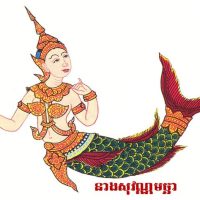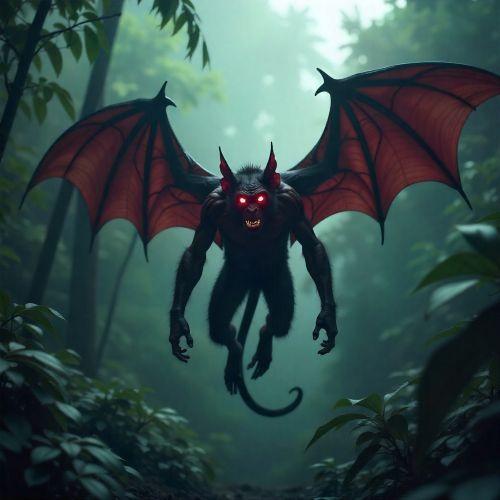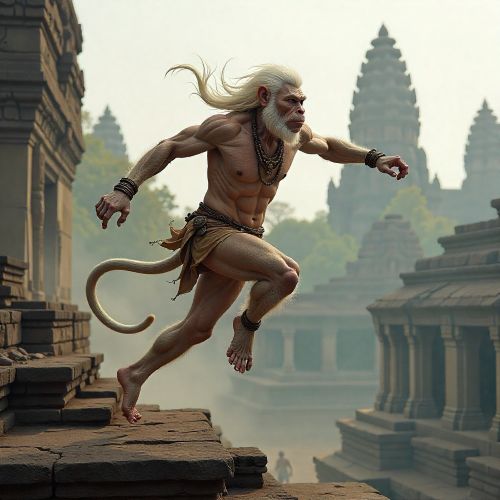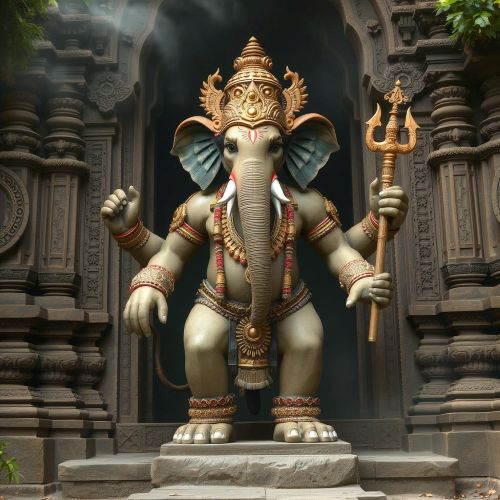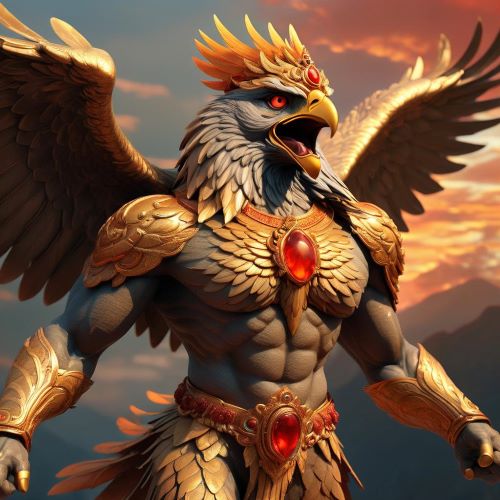Neang Maccha : Cambodia’s Enigmatic Golden Mermaid
Listen
At a glance
| Description | |
|---|---|
| Origin | Cambodian Mythology |
| Classification | Hybrids |
| Family Members | N/A |
| Region | Cambodia |
| Associated With | Mermaid |
Neang Maccha
Introduction
Neang Maccha stands as one of the most enchanting figures in the Reamker, the Cambodian adaptation of the Ramayana. While the Indian epic does not contain her story, the Khmer narrative introduces her as a mermaid princess who guards the sea and challenges Hanuman during his mission to reach Lanka. When the monkey general begins constructing a causeway across the ocean, she commands her mermaids to dismantle his work, sparking a dramatic and unexpected encounter. What begins as a confrontation slowly transforms into a romance, giving the Reamker a uniquely Cambodian layer of emotion, humour, and cultural identity. Through the tale of Neang Maccha, the epic blends Hindu foundations with local animist traditions, water-spirit lore, and the artistic imagination of the Khmer world.
Physical Traits
Neang Maccha is depicted as a mermaid of extraordinary beauty, combining a human upper body with the tail of a fish. In Cambodian classical dance and temple artwork, she radiates elegance through her long, flowing hair, expressive gestures, and serene facial features. Her most distinctive attribute is her shimmering golden tail—an artistic detail that earned her the title Sovann Maccha, meaning “Golden Mermaid.” This golden aesthetic appears prominently in Lakhon Khol performances, murals, and modern illustrations, symbolizing purity, charm, and her supernatural lineage. The careful ornamentation of crowns, jewellery, and intricate costumes highlights her royal status within the underwater realm and her deep connection to the spiritual forces of the sea.
Family
The Reamker does not provide a fixed genealogy for Neang Maccha, leading to variations across regional retellings. In many Cambodian traditions, she is simply a mermaid princess aligned with the aquatic spirits and naga lords that populate Khmer mythology. In other versions—especially those influenced by Thai and Lao Ramayana traditions—she is described as the daughter of Ravana (Krong Reap), which places her directly within the antagonist’s lineage. Regardless of version, her relationship with Hanuman becomes the defining thread of her story. Their union symbolizes harmony between opposing realms: land and water, celestial monkey warriors and marine guardians. In some Southeast Asian narratives, they are said to have a son named Macchanub or Mudchanu, a hybrid child who embodies this union, representing reconciliation between once-conflicting worlds.
Other names
Although most commonly known as Neang Maccha in Cambodia, she is also widely referred to as Sovann Maccha or Suvannamaccha, meaning “Golden Mermaid.” These names emphasize the radiant quality of her tail and her royal aura. In English-language adaptations and children’s retellings, she is sometimes called the “Mermaid Queen” or simply “Lady Fish,” reflecting the literal meaning of her Khmer name. The consistency of her titles across Cambodian art and literature makes her identity one of the more stable components of the Reamker’s mythological tapestry.
Powers and Abilities
As a guardian of the sea, Neang Maccha possesses control over aquatic elements and marine creatures. Her authority becomes evident when she commands her mermaid entourage to remove the stones Hanuman places in the water, hindering the construction of his bridge. Her movements through the sea are described as swift and graceful, reflecting her innate harmony with the ocean. Beyond physical powers, her charm carries a mystical intensity—strong enough to captivate Hanuman himself, a warrior traditionally portrayed as celibate and unwavering in his duty. This ability to shift an enemy’s intention without force highlights her emotional intelligence, a trait often associated with Southeast Asian water deities. Her eventual cooperation with Hanuman represents a symbolic merging of nature and purpose, where the power of compassion becomes as influential as magic or martial strength.
Modern Day Influence
Neang Maccha remains deeply woven into Cambodia’s artistic and cultural identity. Her story forms a key segment of the classical Robam Sovann Maccha dance, a celebrated performance that retells her flirtatious and dramatic encounter with Hanuman through refined gestures and elaborate golden costumes. This episode has become one of the most beloved scenes in the Reamker’s performance tradition.
Her likeness also appears in temple architecture, especially at Angkor Wat, the Royal Palace murals, and wat paintings across the country, where the construction of the causeway and the mermaid intervention are frequently illustrated. In contemporary culture, Neang Maccha has found new audiences through children’s literature, educational programs, animations, and tourism branding. Modern artists reinterpret her tale to highlight themes such as environmental conservation, the importance of water resources, and the strength of feminine autonomy. As a result, she has evolved from a mythic character into a cultural icon representing Khmer heritage, artistic beauty, and the harmonious blending of ancient influences.
Related Images
Source
Wikipedia contributors. (2004, April 27). Reamker. Wikipedia. https://en.wikipedia.org/wiki/Reamker
Wikipedia contributors. (2024, March 7). Robam Sovann Maccha. Wikipedia. https://en.wikipedia.org/wiki/Robam_Sovann_Maccha
Litlover School Blog. (2019, June 17). Reamker (A Cambodian Epic about Magic and Adventure). https://litlover.school.blog/2019/06/17/reamker
CID-DS. Reamker. https://cid-ds.org/reamker
Narayana Murthy, U. (2022). Reamker: Version of Ramayana in Cambodia [PowerPoint slides]. Center for Indian Diaspora Studies. https://cid-ds.org/wp-content/uploads/2022/10/2BC-RAMAYANA-OF-CAMBODIA-REAMKER-Dr-Uma-Narayana-Murthy-Literature.pdf
Bharat Ideology. (2024, January 18). Reamker: The Cambodian Adaptation of the Ramayana. https://bharatideology.com/reamker-the-cambodian-adaptation-of-the-ramayana/
Cravath, P. (2007). Earth in Flower: The Divine Mystery of the Cambodian Dance Drama. DatAsia Press.
Bizot, F. (1994). The Reamker (Ramakerti): The Cambodian Version of the Ramayana. École française d’Extrême-Orient.
Sam, A. (2001). Khmer Classical Dance: Identity and Cultural Continuity. Reyum Publishing.
Ledgerwood, J. (1997). The Cambodian Tuol Sleng Museum of Genocidal Crimes: National Narrative. Museum Anthropology, 21(1), 82–98.
Frequently Asked Questions
Who is Neang Maccha in Cambodian mythology?
Neang Maccha is a golden mermaid princess from the Cambodian Reamker, known for her encounter and eventual romance with Hanuman during the construction of the causeway to Lanka.
Is Neang Maccha part of the original Ramayana?
No. She does not appear in the Indian Ramayana. Her story is a uniquely Cambodian addition that reflects Khmer folklore and local water-spirit traditions.
Why does Neang Maccha stop Hanuman from building the bridge?
She initially thwarts his construction by commanding mermaids to remove the stones, as she serves as a protector of the sea and views the intrusion as a threat.
Did Hanuman and Neang Maccha have a child?
In several Southeast Asian versions, the two have a son named Macchanub or Mudchanu, who possesses both monkey and mermaid traits.
How is Neang Maccha represented in Cambodian culture today?
She appears in classical dance, temple carvings, mural art, literature, and modern creative adaptations, making her one of Cambodia’s most recognizable mythological figures.



